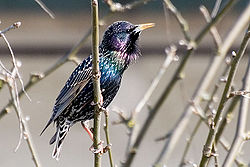Sturnus
| Sturnus | |
|---|---|
 |
|
|
European starling, Sturnus vulgaris vulgaris |
|
| Scientific classification | |
| Kingdom: | Animalia |
| Phylum: | Chordata |
| Class: | Aves |
| Order: | Passeriformes |
| Family: | Sturnidae |
| Genus: |
Sturnus Linnaeus, 1758 |
| Species | |
|
see text |
|
| Synonyms | |
|
Temenuchus (but see Systematics) |
|
see text
Temenuchus (but see Systematics)
Sturnus is a genus of starlings. As discussed below, the taxonomy of this group is complex, and other authorities differ considerably in which species they place in this genus, and in the species boundaries within Sturnus. The genus name Sturnus is the Latin for "starling".
This genus has representatives across most of Eurasia and one species, the European starling, has been introduced to South Africa, North America, Australia and New Zealand.
The Sturnus starlings are terrestrial species; they walk rather than hop, and have modifications to the skull and its muscles for open-bill probing. The latter adaptation has facilitated the spread of this genus from humid tropical southern Asia to cooler regions of Europe and Asia.
The more northerly breeding species are completely or partially migratory, wintering in warmer regions.
Sturnus starlings nest in holes in trees or buildings. They are omnivorous and mostly feed on the ground; they specialise in taking invertebrates from just below the surface. This is facilitated by the head adaptations mentioned above, which enable the birds to probe with the bill open, closing it to secure prey items.
The plumages within this group are variable, but all the species have the starling's familiar triangular wing shape.
The European (the type species) and spotless starlings are particularly closely related, and interbreed to some extent where their ranges overlap in southwestern France and northeastern Spain. The non-migratory spotless starling may be descended from a population of ancestral S. vulgaris that survived in an Iberian refugium during an ice age retreat.
...
Wikipedia
